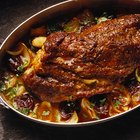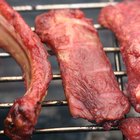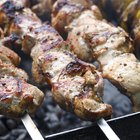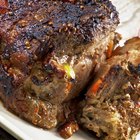
Pulled pork is one of the glories of the Southern barbecue tradition and in recent years, it's gone from a regional specialty to a mainstream favorite. Preparing it the old-fashioned way, over charcoal, takes a long time and a lot of attention, so it's not ideal when you have kids to keep an eye on. It's much more practical to cook your pork in a roasting pan or countertop roaster and rely on seasonings to provide the flavor.
Pork Shoulder
Commercial barbecue joints often cook and pull whole hogs, but for home cooks the traditional choice is a pork shoulder. The loin is fine for chops, but pulled or shredded pork needs to be made from a cut with lots of marbling and connective tissue. Otherwise, it'll be dry and chewy. The shoulder meets those standards perfectly, so all you have to do is cook it patiently at a low temperature until it becomes fork-tender.
Preparing Your Pork
Most enthusiasts recommend seasoning your roast a day ahead and letting it sit overnight while the flavors infuse into the meat. You can find an endless number of recipes for dry rubs or spicy pastes to coat your pork and you can get a pretty good argument started at any gathering by asking which is better. Whichever you choose, rub it into the pork carefully so the entire surface is covered. Don't trim away any fat until after cooking, because it's going to protect your roast from drying out while it bakes.
Baking Your Pork
The next day, place your pork shoulder in a roasting pan with the rind of fat facing up. Add a small amount of water, broth, apple juice, beer, wine or some other liquid, if you wish. It's optional, but adds flavor. Cover the roast and put it in a preheated oven at 300 degrees Fahrenheit, or in a countertop roaster set to the same temperature. The pork is safely cooked when it reaches an internal temperature of 145 F, but for pulled pork it must reach at least 180 F. That's the temperature that makes the roast's connective tissues dissolve into gelatin, giving it its characteristically lush and soft texture.
Shredding Your Pork
When the roast is fork-tender, remove it from the oven and let it rest for 15 to 20 minutes. Pour off the juices into a container and let them stand while you shred the pork. Remove the fat cap and set it aside, then lift out the pork onto a baking sheet or large platter. Use two forks -- or gloved hands, if your fingers are heatproof -- to pull or shred the pork into strips. Remove any large pieces of fat. When you're done, ladle off the fat from your cooking juices and use them to moisten the meat. If you have extra, you can thicken the juices to make a sauce for your pork.
Related Articles

How to Cook a Boston Butt in a Crock ...

What Is the Safe Cooking Temp for a ...

How to Cook Pork Pinwheels

How to Use a Roaster for Pork

How to Bake a Dry Rubbed Corned Beef ...

Low-Temperature Cooking of Baked Pork

How to Cook Pork Tenderloin in a ...

How to Use Grill Mates Pork Rub

How to Cook a Tender Lamb Breast
How to Brine Pork Ribs for a BBQ

How to Barbecue Bologna on a Charcoal ...
How to Convection Cook a Pork Shoulder ...

How to Save Overcooked Pork

Barbecue Tips for Pork Rib Brisket
How to Cook Pork Rib Slabs

How to Cook a Rump Roast Without ...

The Secret to Cooking Tender Pork

How to Cook Marinated Pork Loin From a ...

How to Grill a Boneless Leg of Lamb ...

How to Roast a Pork Blade Cut
References
- On Food and Cooking: The Science and Lore of the Kitchen; Harold McGee
- Pork -- Be Inspired: Herb Rub Oven-Braised Pulled Pork
- Pork -- Be Inspired: Shoulder
Writer Bio
Fred Decker is a trained chef and certified food-safety trainer. Decker wrote for the Saint John, New Brunswick Telegraph-Journal, and has been published in Canada's Hospitality and Foodservice magazine. He's held positions selling computers, insurance and mutual funds, and was educated at Memorial University of Newfoundland and the Northern Alberta Institute of Technology.
Photo Credits
Jupiterimages/liquidlibrary/Getty Images